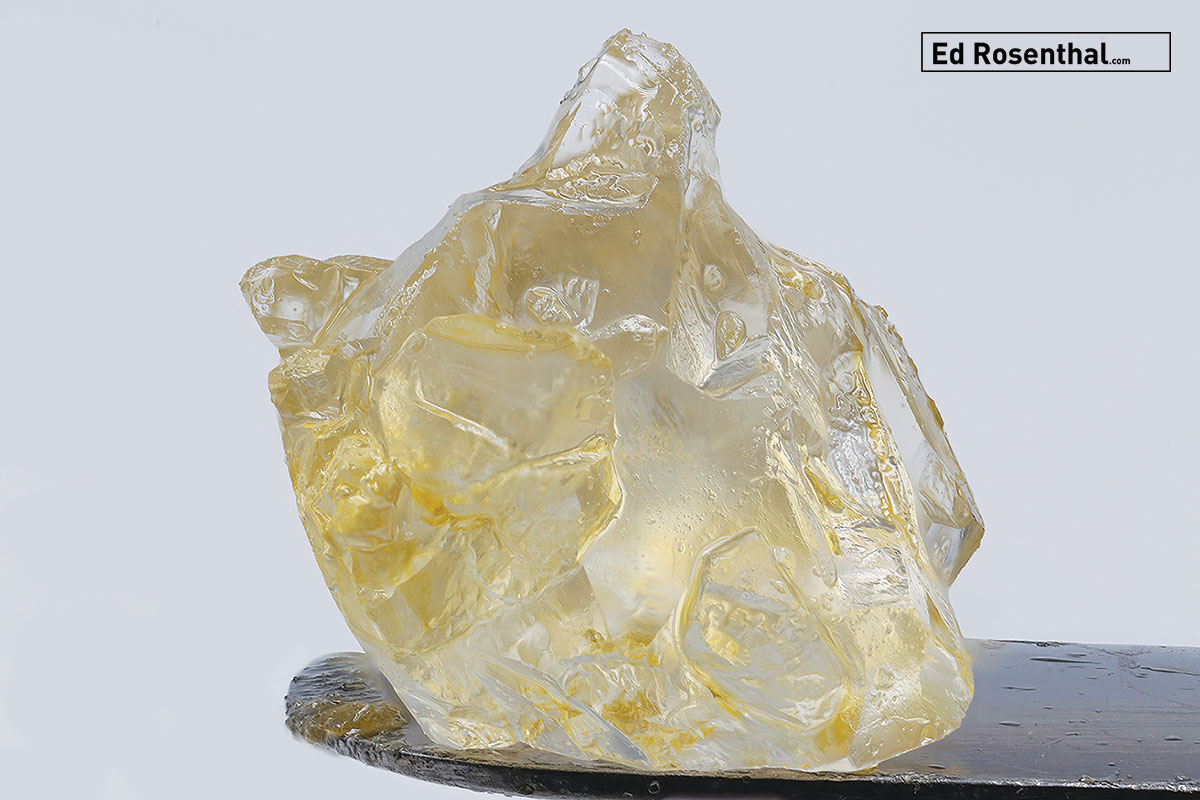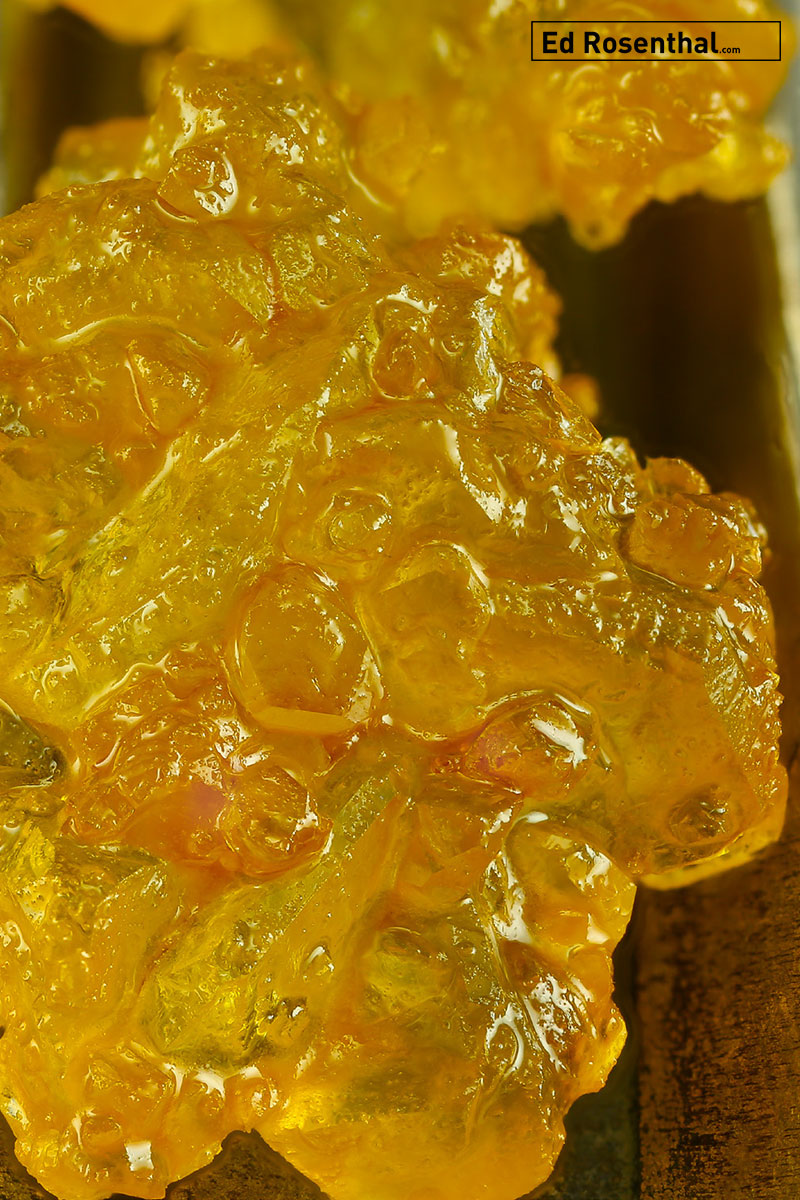DIAMOND MINING WITH LIVE RESIN : A step by step guide to the recrystallization process
BHO LIVE RESIN, PlatinumN7 by Harmony Extracts
First and foremost, this is all basic organic chemistry, in this case, a process called “recrystallization.” There are several other names, two primary ones being Diamond Mining and Jar Tech, which refer to the end product and a technique for achieving it, respectively.
Diamond Mining is all about encouraging separation of cannabinoids from terpenes. The end product can be incredibly flavorful and potent, and many dabbers who prefer live resin also prefer the crystallization of “terp sauce.”
BHO Concentrate. Photo by Professor P of Dynasty Genetics
Shatter made from live resin has a higher terpene concentration than cured resin, which tends to be more susceptible to nucleation, creating terp sugar or budder after it has been packaged. This was once seen as a liability, as it undermines the stability that consumers look for in a good shatter. Now that many cannabis consumers prefer the sugar consistency, extractors precrystallize their BHO.
The biggest appeal of live resin is the elevated terpene content that leads to the physical separation associated with sauces and sugars. The only problem is that once the product separates, the increased terpene concentration is only temporary. The sugar consistency is the result of solid cannabinoids separating from the liquid terpenes, lending a more robust aroma but resulting in rapid terpene loss through evaporation.
A word on recrystallization
A single diamond of crystallized THC-A from a batch of Albert Walker Live Resin, Marquise Diamond Series by First Class Concentrates
My recent book, Beyond Buds, Next Generation, focuses on recrystallization methods for hydrocarbon extracts because the majority of commercially available recrystallized products are made using hydrocarbons. However, it is technically possible to recrystallize any cannabis concentrate that hasn’t been decarboxylated; as long as there are cannabinoid acids present, they can be used to create crystalline structures. However, all the well-established methods of recrystallization require the use of solvent of some kind.
There are a variety of methods for producing a crystalline cannabis concentrate, including fractional distillation, but one of the simplest and most time-consuming involves little more than time and terpenes.
Diamond Mining
Diamonds by Harmony Extracts
Diamond Mining can be done with cured resin, but live resin more readily lends itself to the process. As with all extraction, starting material is the key to everything that follows, and there are no short cuts or workarounds when it comes to this step — get the loudest, most potent cannabis available. Each strain has idiosyncratic qualities when it comes to resin stability, crystallization potential, and so on, and most of extraction is science, but this is one of those areas where it becomes something of an art form. Selecting the strain that best suits the desired end product is all about trial and error.
The process starts the same way all BHO products do — with butane extraction. Once you’ve extracted the unpurged live resin it’s time to do a light, no-vac purge at roughly 90°F — no higher than 100°F. This will off-gas most, but not all, of the residual solvent. The resin is now placed into containers where it is left to separate for two to three weeks. During that time cannabinoid crystals start to form on the bottom of the container as the solids separate from the terpenes, forming a semiviscous liquid layer on top. When you’re satisfied with the stacking of the crystals, it’s time for the final purge.
Live Nectar™ consists of terpene-rich sauce covering crystals of raw THCa by Harmony Extracts.
If possible, separate the liquid layer from the crystals and purge them separately. The terpene layer will be more or less liquid, making it fairly easy to pour off. This allows for a slightly longer purge on the crystals, roughly 72 hours, versus 60 or so for the terp sauce. If for some reason your layers are difficult to separate, the entire batch can be purged together, but it should still be purged for less time than a shatter; shatter is generally purged for at least 100 hours, but with Diamond Mining, the resin has already been partially purged and has also been off-gassing in the container for weeks.
Once the purge is complete, the liquid and solid products are recombined and packaged, preferably in a UV-proof container to slow the loss of terpenes. The natural separation of cannabinoids and terpenes employed in this process are pronounced but not total. That means the terpene-rich semi-fluid portion will still contain anywhere from 30% to 50% cannabinoids.
Diamond Mining: 9 steps to the recrystallization process
Frozen Cannabis by Harmony Extracts.
1. Extract some BHO from some quality material. Dried, cured buds work fine, but live resin is the best starting material.
2. When the BHO is still highly viscous, pour it into a mason jar. Place a lid on the jar.
3. Place the jar somewhere where it stays above room temperature, taking specific note of the formation of the crystalization. Slightly lower or higher temperatures can affect the length of the process or the overall size and clarity of the formations.
4. You may need to vent pressure from your jar so that opening it when you check on it is just fine.
Molten sauce flows over geodes of THCa, reeking of Harmony’s garden by Harmony Extracts.
5. As time passes in this soupy pressurized state, THCA crystals begin to form and fall out of suspension to the bottom of the jar. The volatile terpenes rise to form a viscous layer on top of the mix in the jar.
6. When you’re happy with the crystal formation, you can pour off the terps to separate the crystals.
7. Terpenes can be stabilized by purging, re-added to the crystals for flavor or made into their own dabbable product.
8. To further refine the THCA you can wash it in another hydrocarbon such as pentane to try to remove the remaining residual solvents.
9. Dab it.
Warning: It is highly likely the jar will need to be burped if heated above room temperature. The more heat you use in this step the faster the solvent converts to a gaseous form. You are are intentionally heating the material SLOWLY in an effort to mine as large and as clear a crystalline formation as you can. Adding more heat means more internal temperature in your jar. If your jar fails to hold the pressure it can shatter sending broken glass flying everywhere. Jars should be placed in a receptacle to minimize danger to the extractor. Always wear proper protective equipment.
Live resin can provide a more flavorful product
BHO LIVE RESIN, Ascent pancake white.
With a few exceptions, the process is no different from extracting cured resin. Since live resin lends itself more readily to crystallization, it’s a perfect choice if you’re looking to focus on sugars and terp sauces instead of shatters.
Finally, remember that there are two basic approaches to extraction. The original approach, which inspired the name of this book’s predecessor Trash to Stash, is all about taking trim and other less desirable parts of the cannabis plant (or less successful crops) and turning them into something that still provides high potency. The newer approach is about condensing and high-lighting desirable elements in quality material — live resin falls squarely in this category.
There’s no wrong way to approach the processing of cannabis, as long as you have a clear picture of where you’re trying to go. For those seeking a way to process large quantities of larf, live resin is a dead end. For those focusing almost exclusively on terpene profiles, it’s a golden ticket.
Join our cannabis community
Follow Us














